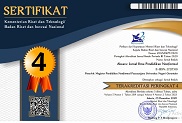Unique Derivative Affixes In Simalungun Language (Morphosyntax Study)
Abstract
Keywords
Full Text:
PDFReferences
Adedoyin, O. B. (2020). Qualitative Research Methods. Principles of Social Psychiatry:
Second Edition, 77-87. https://doi.org/10.1002/9780470684214.ch7
Adlof, S. M., & Catts, H. W. (2015). Morphosyntax in poor comprehenders. Reading and
Writing, 28(7), 1051-1070. https://doi.org/10.1007/s11145-015-9562-3
Barung, K. (2020). KEPRODUKTIFAN AFIKS DALAM PROSES MORFOLOGIS.
Prolitera, 3(1), 40-58. http://unikastpaulus.ac.id/jurnal/index.php/jpro/
Basyaruddin. (2014). Morfosintaksis Bahasa Melayu Batu Bara (Kajian Pada Verba
Persepsi: Tengok(lihat) dan dongok (dengar)). B A H A S, Oktober-De(91), 1-13.
Benson, P., Chik, A., Gao, X., Huang, J., & Wang, W. (2016). Qualitative research in
language teaching and learning. 93(1), 79-90.
Bjorkman, B. A. M. (2011). BE-ing Default: The Morphosyntax of Auxiliaries [Universiteit Leiden]. In ProQuest Dissertations and Theses.
https://dspace.mit.edu/handle/1721.1/68911%0Ahttp://search.proquest.com/docvie
w/923618410?accountid=13042%5Cnhttp://oxfordsfx.hosted.exlibrisgroup.com/ox
ford?url_ver=Z39.88-
&rft_val_fmt=info:ofi/fmt:kev:mtx:dissertation&genre=dissertations+&+thes
es&si
Candrasari, R. (2018). Morphological process of devayan: An analysis of morphological
tipology. Emerald Reach Proceedings Series, 1, 27-33. https://doi.org/10.1108/978-
-78756-793-1-00045
Creswell, J. W. (2008). Qualitative Inquiry & Research Design. SAGE Publications Ltd.
Creswell, J. W. (2014a). Qualitative, Quantitative, and Mixed Methods Approaches. In
Research Design: Qualitative, Quantitative, and Mixed Methods Approaches
(Second Edi, pp. 1-26). SAGE.
Creswell, J. W. (2014b). Research Design: Qualitative, Quantitative, and Mixed Methods
Approaches (Fourth Edi). SAGE Publications Ltd.
Cropley, A. (2019). Introduction to qualitative research methods. In A research handbook
for patient and public involvement researchers.
https://doi.org/10.7765/9781526136527.00012
Damanik, U. H., Sinaga, M., Bakar, A., & Purbo, J. (1984). Morfologi dan Sintaksis
Bahasa Batak Simalungun. In Morfologi dan Sintaksis (Vol. 53, Issue 9, p. 119).
Hendrick, R. (2003). Minimalist Syntax. In GastronomÃa ecuatoriana y turismo local.
(Vol. 1, Issue 69). Blackwell Publishing Ltd.
Nurhayati, D. A. W. (2016). Investigating Morphological Process of Payandra on
Javanese Metaphor. Journal of English Language Teaching and Linguistics
(JELTL), 1(3), 245-259. https://doi.org/10.21462/jeltl.v1i3.34
Pramudiah, P. W., Setyadi, A., Tiani, R., & Hum, M. (2018). Proses Morfologis Kata
Maju Beserta Turunnya. Universitas Diponegoro, 024, 1-10.
Ratnasari, ori, A. (2017). Pemetaan Afiksasi Buku Juara Jurnal Bahasa Indonesia
Mahasiswa BIPA 2016 / 2017 PEDOMAN PENULISAN ARTIKEL E-JOURNAL
UNESA Pemetaan Afiksasi Buku Juara Jurnal Bahasa Indonesia Mahasiswa BIPA
/ 2017 Abriani Ori Ratnasari Pendidikan Bahasa dan Sastra In. E-Journal
UNESA, 1-9.
Roxana de Trigueros, J. F. H. S. (2017). Qualitative and quantitative research.
Psychologist, 10(4), 159-160. https://doi.org/10.4324/9781003057260-26
T, G. (2001). syntax An Introduction (Volume 1). John Benjamins Publishing.
To'umbo, Y. M. (2017). Afiks Pembentuk Verba dalam Bahasa Pamona. Jurnal Skripsi,
(9), 1689-1699.
Zainuddin. (2015). Sistem Morfologi Bahasa Gayo : Kajian Transformasi Generatif.
Jurnal Bahas, 37(1), 2.
https://jurnal.unimed.ac.id/2012/index.php/bahas/article/view/3086
DOI: http://dx.doi.org/10.37905/aksara.8.2.1383-1392.2022
Refbacks
- There are currently no refbacks.
Copyright (c) 2022 Aksara: Jurnal Ilmu Pendidikan Nonformal

This work is licensed under a Creative Commons Attribution-ShareAlike 4.0 International License.
Publisher:
Magister Pendidikan Nonformal Pascasarjana Universitas Negeri Gorontalo
Jl. Soedirman No. 06 Gorontalo 96128 e-mail: jurnalaksara@ung.ac.id
http://ejurnal.pps.ung.ac.id







